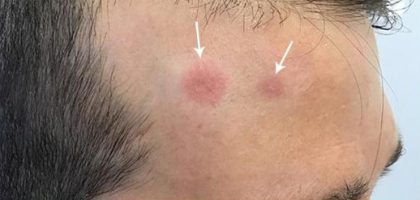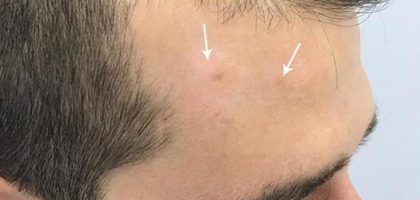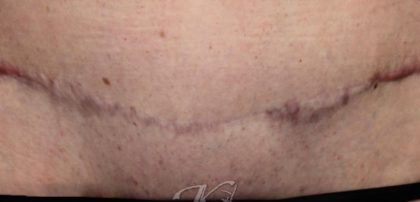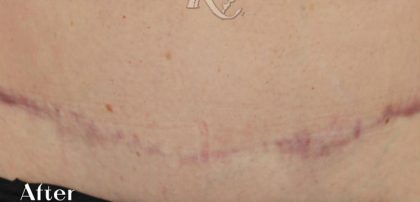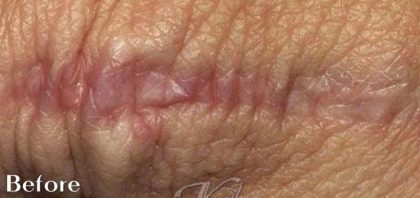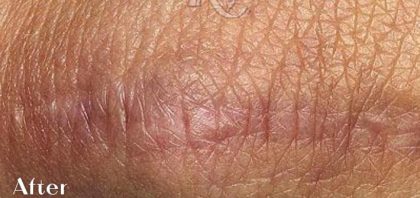Scars
Conveniently located to serve the areas of Santa Monica and Los Angeles
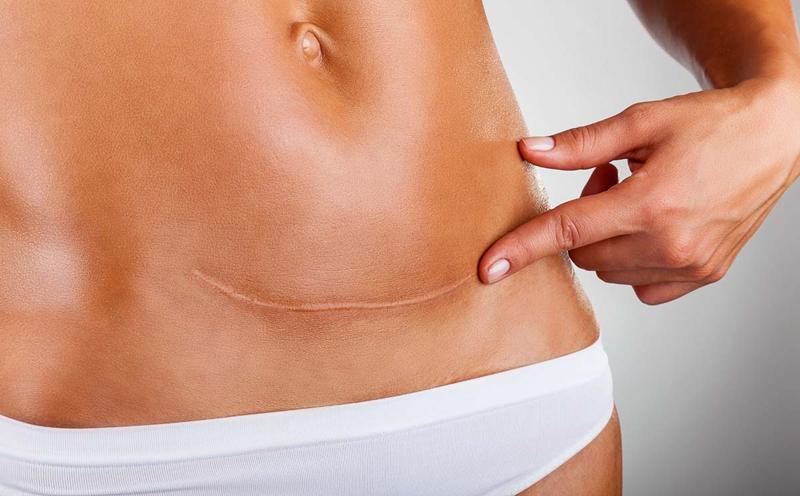
Treating scars is an effective way to restore your skin for a smoother appearance after surgery, acne, or injury. Acne from hormonal changes can lead to disfiguring scars that alter your appearance, especially when they develop in areas that are difficult to conceal like the face. Acne-prone skin is especially susceptible to scarring. In a recent study, 47% of people who suffered from acne also experienced scaring. (1) Whether you have scars from acne, surgery, or injury, you do not have to live with them.
Contents
- 1 Before and After Photos
- 2 About Scar Treatments
- 3 What We Can Do
- 4 Candidates for Scar Treatments
- 5 Scar Treatment Consultation
- 6 VBeam Laser Scar Treatments
- 7 Fraxel Laser Therapy
- 8 Cortisone Injections
- 9 Blood Facial PRP
- 10 Corresponding Procedures
- 11 The Cost of Scar Treatments in Santa Monica
- 12 FAQ
- 13 References
Before and After Photos
The team at Derm & Rejuvenation Institute has decades of experience helping patients restore their skin and diminish the appearance of stubborn scars. Dr. Tanya Kormeili is a board-certified dermatologist, medical consultant, and professor who has helped thousands of patients experience the benefits of skin rejuvenation and scar treatments.
Contact our office or call (310) 526-8301 to learn more about the scar treatments that have helped hundreds of patients fall back in love with their bodies.
About Scar Treatments
If you are contemplating scar removal or struggling to conceal scars from acne, surgery, or injury you are not alone. Disfiguring scars can be devastating and difficult to treat on your own, especially large surgical scars. Before treating your scars, we will perform a physical examination to determine the most effective treatment based on the type of scar you have. Scars can have several features in terms of shape and color and we will consider all of these aspects for the best results.
Types of Scars
There are many different types of scars: atrophic scars, hypertrophic scars, boxcar scars, pitted scars, acne scars, and keloids. Atrophic scars cause small depressions in the skin and are one of the most common types of scars. Hypertrophic scars, raised bumps that look similar to acne scars, often occur on the face and are caused by excess collagen in the skin.
Scars can be white, red, or hyperpigmented (dark) in color and change appearance as they move through the various healing stages.
What Happens When A Scar Forms?
Scar formation is a natural part of your body’s healing process, and scars are designed to take the place of lost or damaged skin. When a scar forms, the skin becomes inflamed and your body rebuilds the lost tissue. With time, the scar becomes flatter and fades into your skin. With scar treatments, we can improve the appearance of disruptive scars that have not faded.
What We Can Do
- Minimize Surgical Scars: Surgical scars are extremely common. In developed countries, approximately 100 million people suffer from surgery-related scars each year. (2) If you are suffering from surgical scars, we can reduce them safely.
- Improve Acne Scars: Scar treatments can help your skin recover from acne scarring. Acne scars are commonly caused by genetics, hormonal changes, and made worse by sun exposure.
- Treat Keloid Scars: Keloid scars are thick scars with a raised appearance that create a visible disruption to your skin. We offer several treatments for keloid scars which are commonly treated with laser therapy, freezing, and corticosteroid cream or injections.
Candidates for Scar Treatments
You are likely a good candidate for a scar treatment if you have scars from acne, surgery, or injury. The best candidates are usually experience the following symptoms:
- Facial scars that result in textured skin
- Thick, raised scars
- Post-surgical scars that are difficult to conceal
- Acne scars that create divots in the skin
The best candidates lead a healthy lifestyle and do not smoke. After a scar treatment, you will need to take good care of your skin for the best results. Wearing SPF, avoiding sun exposure, and maintaining an effective skincare routine will be important for your recovery.
Scar Treatment Consultation
During your consultation, we will discuss your current lifestyle, and whether or not you have a history of skin diseases or conditions that would affect the outcome of your treatment. We will discuss your surgical goals and expectations for the procedure and determine the right treatment for your needs. To learn more about how we can help you meet your body goals, contact our office to schedule an appointment.
VBeam Laser Scar Treatments
VBeam laser treatments treat red, discolored scars on the body and are especially useful for treating the face. If you struggle with acne scars, rosacea, spider veins, or red areas on your neck we can treat them with laser therapy. VBeam is a vascular laser because it reduces the appearance of underlying blood vessels that cause scars to look bright red. We can also treat keloid scars with lasers.
How It Works
During a VBeam laser treatment, the device will reduce the color of your scar by destroying the blood vessels causing the redness. The treatment will help your scars blend into your skin by shrinking the blood vessels that cause bright red hues that call attention to your scars. The laser will target the blood vessels without affecting the surrounding skin for a safe and effective solution.
Fraxel Laser Therapy

Fraxel laser therapy stimulates collagen production (neocollagenesis) to help your body naturally heal and reduce the appearance of scars. Collagen is a protein that repairs your skin and helps it maintain its firm, youthful appearance. Fraxel laser therapy provides the skin with the collagen that decreases as we age.
How It Works
During a Fraxel Laser Therapy treatment, we will apply a topical anesthetic before using the laser for a comfortable treatment. The laser provides heat that affects the lower layers of your skin to trigger the healing process and stimulate collagen production. We will use a numbing cream for a comfortable procedure and can use this therapy in addition to PRP to stimulate collagen for the best results. Our treatments are customizable, and we will help you determine the best combination during your consultation.
Cortisone Injections
Cortisone injections decrease inflammation and are an effective treatment for reducing the appearance of scars. Cortisone improves the appearance of scars because it helps your body reduce the collagen fibers that form scar tissue in hypertrophic scars. These injections will help reduce the appearance of raised scars by breaking down the fibers for a smoother, more discrete scar that is not as noticeable.
How It Works
During a cortisone injection treatment, Dr. Kormeili will cleanse the treatment area and inject the cortisone into the scar tissue to decrease inflammation. After the injection, you may experience some temporary discomfort at the injection site or discoloration that will subside as your body adjusts to the treatment. Cortisone injections are generally well-tolerated and only require a 15-20-minute appointment.
Blood Facial PRP
A Blood Facial PRP treatment, colloquially known as a “Vampire Facial” harnesses the power of your own blood to help your skin rejuvenate. The first step in facial scar removal is identifying the type(s) present at the respective scar healing stages. Although some patients prefer to treat acne scars with injectables, PRP is a more natural approach that helps your skin regenerate with its own tissue without the use of hyaluronic acid to fill in the area for patients who prefer it.
How it Works
During a Blood Facial PRP treatment, Dr. Kormeili will draw your blood and purify it in a centrifuge to extract the PRP. We will use a small needle to inject into your skin to reduce the appearance of facial scars. The PRP helps the skin naturally regenerate. We can combine this with customized skincare to maximize your results at home. To learn more about skincare treatments, browse the shop.
Corresponding Procedures
During a scar treatment, our team can perform complementary procedures to help you address the appearance of stretch marks and skin damage.
Stretch Marks
If you are experiencing stretch marks after pregnancy or teenage growth spurts, you are not alone. We can minimize scars and stretch marks in one appointment. Fraxel laser treatment doubles as a stretch mark treatment, and Dr. Kormeili can easily treat both skin concerns during your visit. You do not have to live with distracting stretch marks that change the way you feel about your body.
Skin Damage
As you age, the effects of skin damage from sun exposure become more prominent. Conveniently, many of our scar treatments double as skin damage treatments. Discoloration, redness, and spots across the skin are just a few of the effects of sun exposure. Melasma is a sun-related skin condition that can cause dark patches of discoloration to appear across your face. We can treat skin damage with chemical peels, Fraxel Laser Therapy, IPL Photofacial Therapy, VBeam Laser Treatment, or Blood Facial PRP. To learn more about our regenerative skin procedures, see our blog.
The Cost of Scar Treatments in Santa Monica
The cost of your scar treatment will depend on its severity and size. Our team will work with you to make your treatment financially accessible. Contact our office or call (310) 526-8301 to learn more about how our scar treatments can help you reclaim your body.
FAQ
Will scar treatment completely eliminate my scars?
While scar treatment can significantly minimize the appearance of scars, complete elimination may not be possible in all cases. The primary goal of scar treatment is to improve the texture, color, and overall appearance of scars. With appropriate techniques and consistent care, scars can become less noticeable and blend more naturally with the surrounding skin.
Does scar treatment hurt?
Depending on the type of treatment you have, you may have some temporary discomfort around the treatment area.
Will I need more than one scar treatment?
If you have thick scars, you may need more than one type of scar treatment. During your consultation, we will examine your skin to determine a personalized treatment plan.
Will insurance cover the cost of scar treatment?
Scar treatment may or may not be covered by insurance, depending on various factors such as the nature of the scars, associated symptoms, and medical necessity. Typically, cosmetic scar treatments are considered elective procedures and are not typically covered by insurance.
References
- Liu, Lin, et al. “Prevalence and Risk Factors of Acne Scars in Patients with Acne Vulgaris.” Skin Research and Technology, vol. 29, no. 6, 1 June 2023, https://doi.org/10.1111/srt.13386. Accessed 15 Oct. 2023.
- Jourdan, Marie, et al. “Skin Care Management for Medical and Aesthetic Procedures to Prevent Scarring.” Clinical, Cosmetic and Investigational Dermatology, vol. Volume 12, Oct. 2019, pp. 799–804, https://doi.org/10.2147/ccid.s218134.





